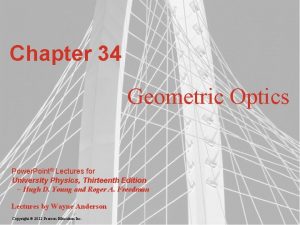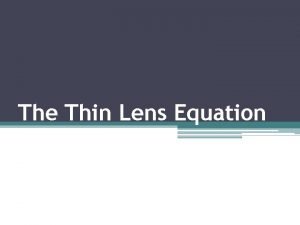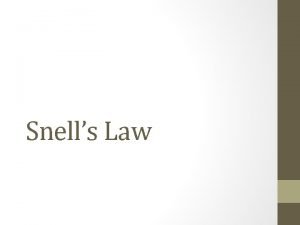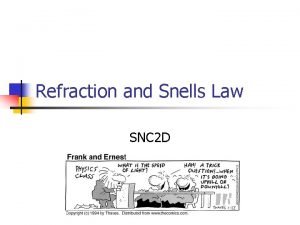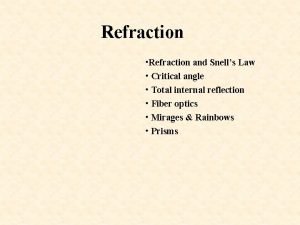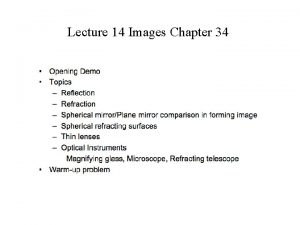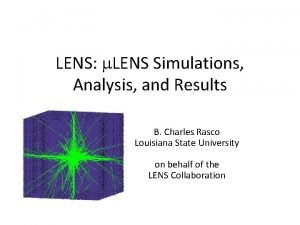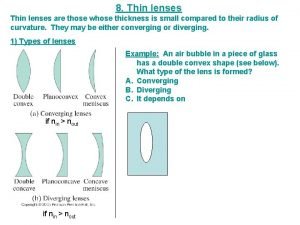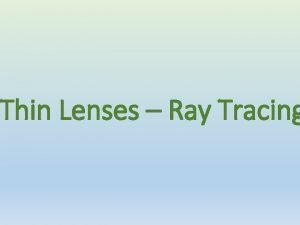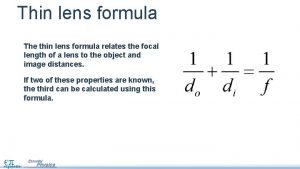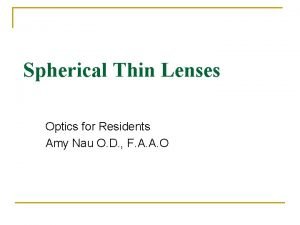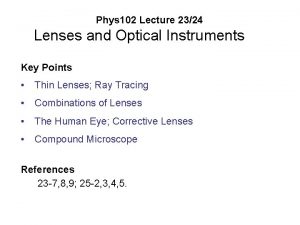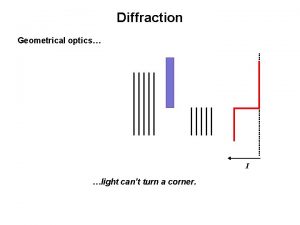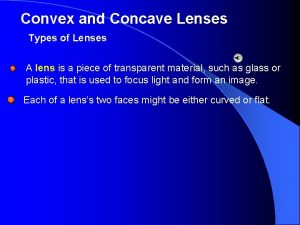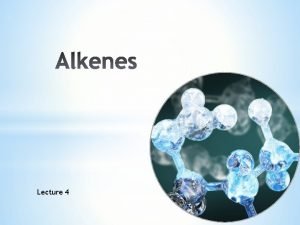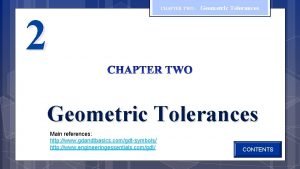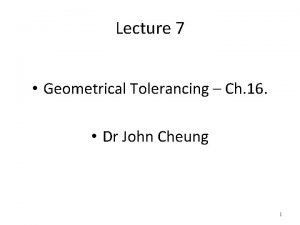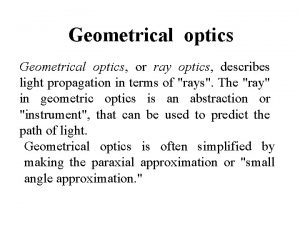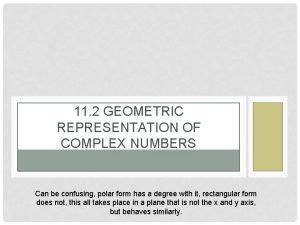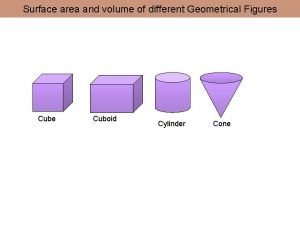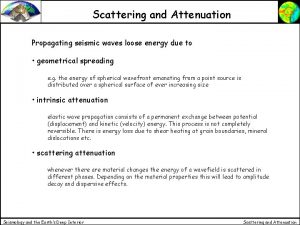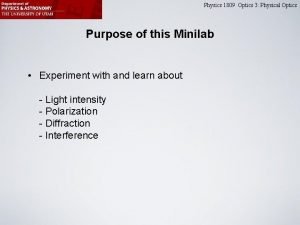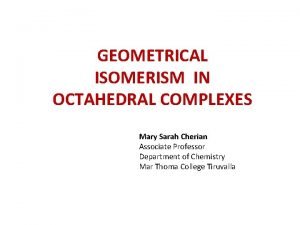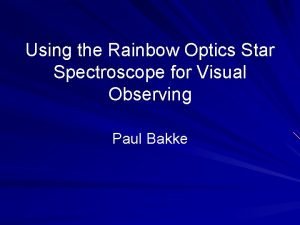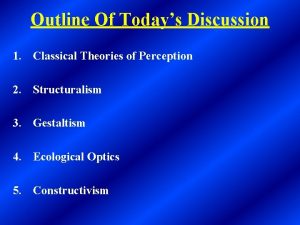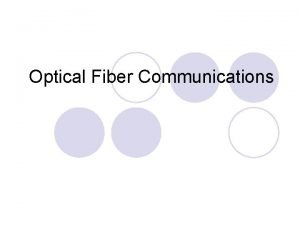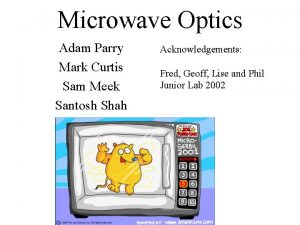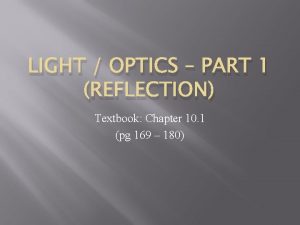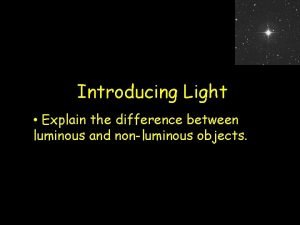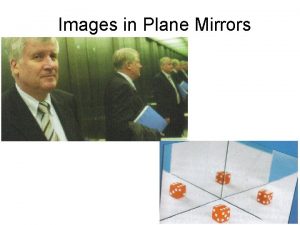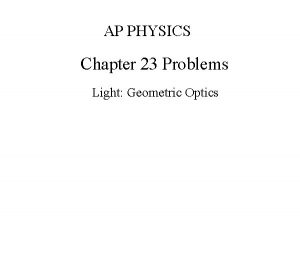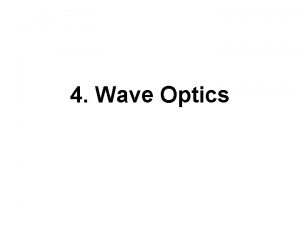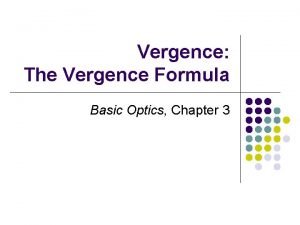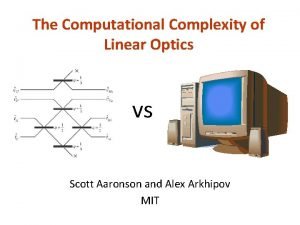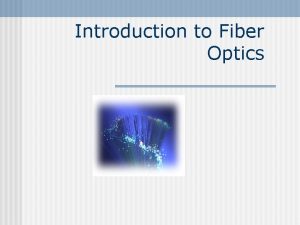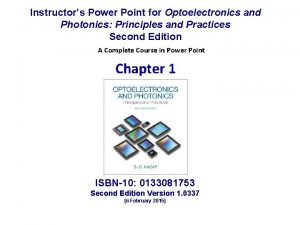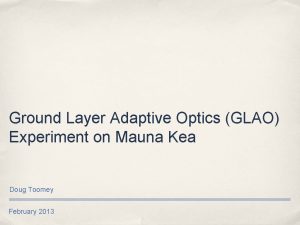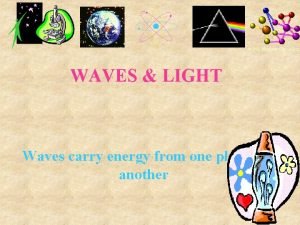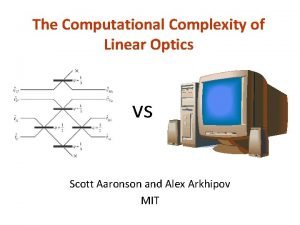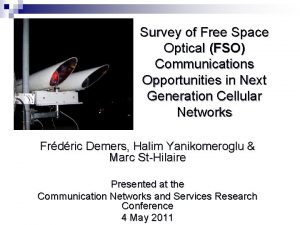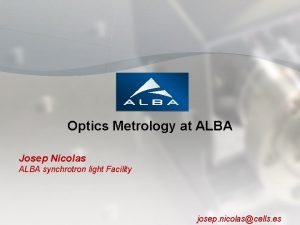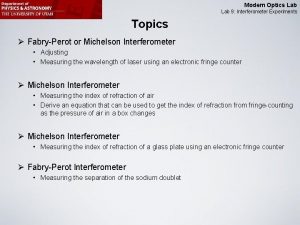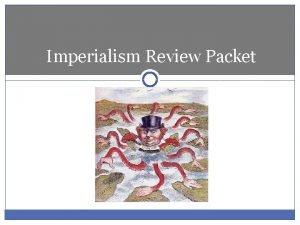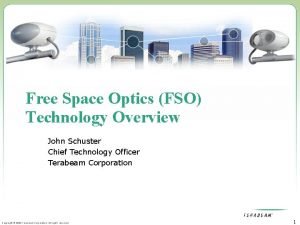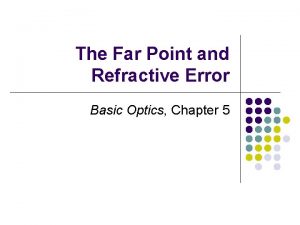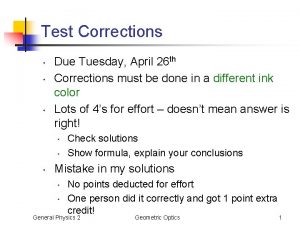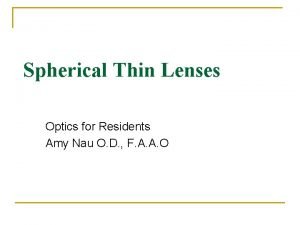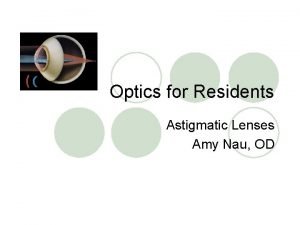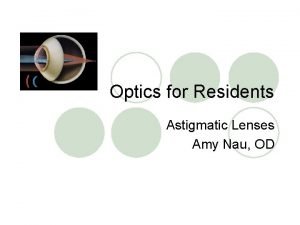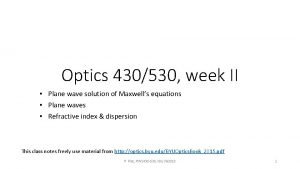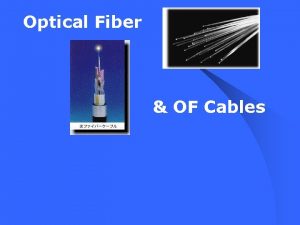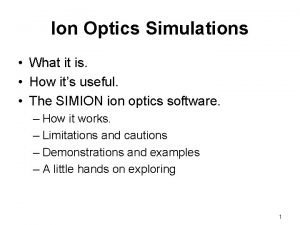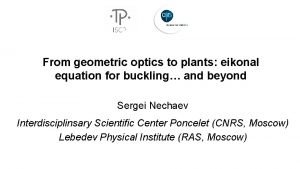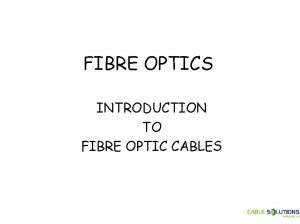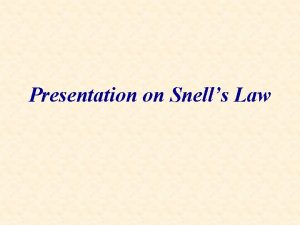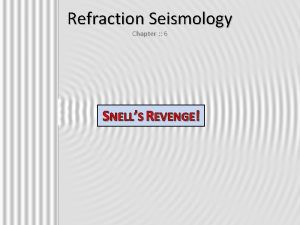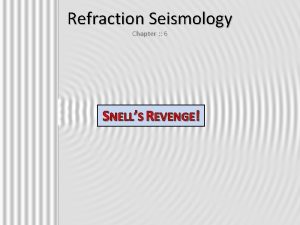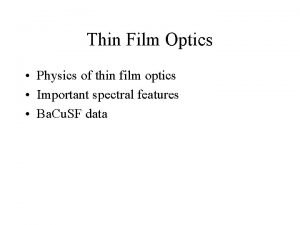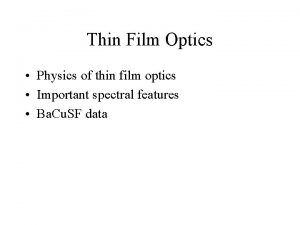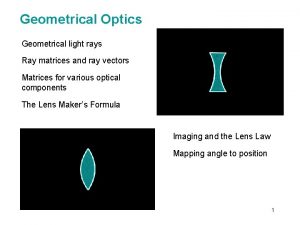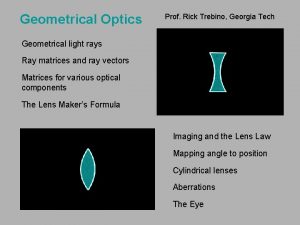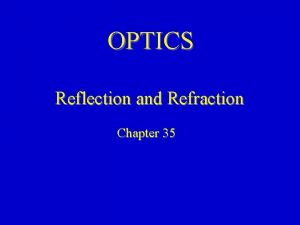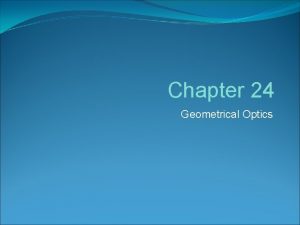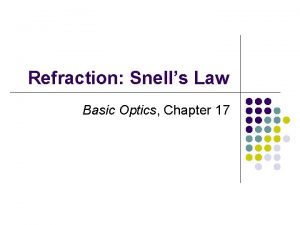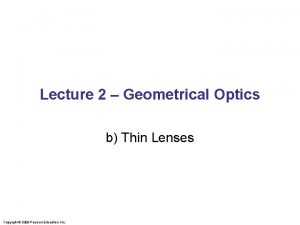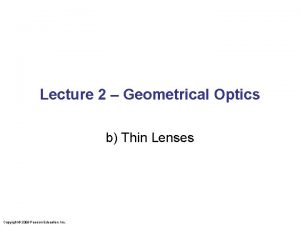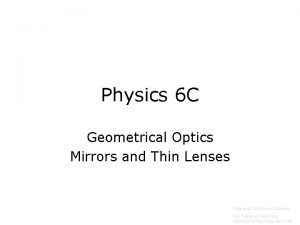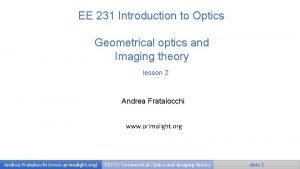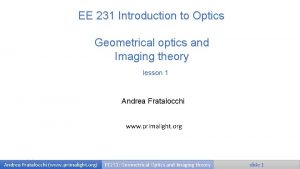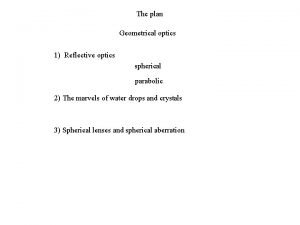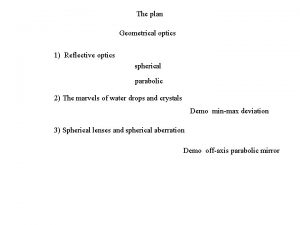Chapter 26 Geometrical Optics Snells Law Thin Lens








































































- Slides: 72

Chapter 26 Geometrical Optics Snell’s Law Thin Lens Equation

1) Index of Refraction, n Speed of light is reduced in a medium Air Water Glass Diamond 1. 000293 4/3 1. 5 2. 4

2) Snell’s Law a) Reflection and Transmission light splits at an interface Transmitted ray

Transmitted ray

(b) Refraction: Transmitted ray is bent at interface toward normal if n increases

away from normal if n decreases

c) Derivation of Snell’s Law toward normal if n increases


Example: Rear-view mirror

Example: Apparent Depth

x d’ 1 For small angles, d

3) Total internal reflection a) The concept For small values of 1, light splits at an interface

For larger values of 1, 2 > 90º and refraction is not possible Then all light is reflected internally Note: this is only possible if n 1 > n 2

b) Critical incident angle Snell’s law:

Some critical angles Water-air: 49º Glass - air: 42º Diamond - water: 33º Diamond - air: 24º Why diamonds sparkle

c) Prisms (glass-air critical angle = 45º)

Prisms in binoculars – Longer light path – Image erect

d) Fibre optics Low loss transmission of light, encoded signals.

Fibre optic bundles, coherent bundles Imaging applications: endoscopy


4) Dispersion • Index of refraction depends on wavelength

Rainbow

Sun Dogs (parhelia)

5) Image Formation a) Seeing an object Diffuse reflection

b) Image formation with a pinhole Diffuse reflection screen

Characteristics of pinhole imaging – Infinite depth of field (everything in focus) – Arbitrary magnification – Low light (increasing size produces blurring) Diffuse reflection screen

c) Ideal lens

Characteristics of the ideal lens – All rays leaving a point on object meet at one point on image – Only one perfect object distance for selected image distance (limited depth of field -- better for smaller lens)

6) Thin lenses a) Converging - thicker in the middle

(i) Parallel coaxial rays converge at focus Reversible

(ii) Symmetric - rays leaving focal point emerge parallel (f’ = f)

(iii) Ray through centre undeviated

Summary of ray tracing rules for converging lens

b) Diverging - thinner in the middle

(i) parallel, coaxial rays diverge as if from focus Reversible

(ii) symmetric - rays converging toward focus emerge parallel

(iii) ray through centre undeviated

Summary of ray-tracing rules for diverging lens

c) Real lenses: - usually spherical surfaces - approximate ideal lens for small angles (paraxial approximation)

7) Image Formation with thin lenses (ray tracing) (a) Converging lens - real image Use 2 of 3 rays:

camera /CCD sensor

(b) Converging lens - virtual image

(c) Diverging lens - virtual image

8) Thin Lens Equation a) The equation

b) Sign Convention (left to right) (i) Focal Length: f > 0 converging f < 0 diverging (ii) Object distance do > 0 left of lens (real; same side as incident light) do < 0 right of lens (virtual; opposite incident light) (iii) Image distance di > 0 right of lens (real; opposite incident light) di < 0 left of lens (virtual; same side as incident light) (iv) Image size hi > 0 erect hi < 0 inverted

c) Lateral magnification Definition: From geometry (and sign convention):

9) Compound Lenses Image of first lens is object for the second lens. Apply thin lens equation in sequentially.


Overall magnification is the product:

Example: Problem 26. 66 Find final image and magnification.

10) Vision and corrective lenses a) Anatomy of the eye

120 x 106 rods - detect intensity: slow, mono, sensitive 6 x 106 cones - detect frequency: R - 610 nm, G - 560 nm, B - 430 nm

b) Optics - Accomodation: focal length changes with object distance - near point: nearest point that can be accomodated - normally < 25 cm - far point: furthest point that can be accomodated - normally ∞

c) Myopia - far point < ∞ - near-sighted (far-blind) - correction: object at ∞ --> image at far point

Correction: object at ∞ --> image at far point (ignoring the eye-lens distance)

d) Refractive Power For a far point of 50 cm, f = -50 cm, Lens prescription: -2

e) hyperopia (hypermetropia) - near point > 25 cm - far-sighted (near-blind) - correction: object at 25 cm --> image at near point

Correction: object at 25 cm --> image at near point (ignoring the eye-lens distance) For near point of 40 cm, f = 66 cm Power = + 1. 5 (reading glasses)

Examples: Problem 26. 73 Age 40: f = 65. 0 cm --> NP’ = 25. 0 cm Age 45: NP’ --> 29. 0 cm (a) How much has NP (without glasses) changed? (b) What new f is needed? Problem 26. 75 FP = 6. 0 m corrected by contact lenses. (Find f) An object (h = 2. 0 m) is d = 18. 0 m away. • Find image distance with lenses. • Find image height with lenses.

11) Angular Magnification a) Angular size

b) Angular magnification

12) Magnifier With magnifier: (Magnifier allows object to be close to the eye)

Without magnifier: Highest magnification (di = -N): (tense eye) Lowest magnification (di = -∞): (relaxed eye) (Magnification quoted with N = 25 cm, for relaxed eye)

Example: Problem 26. 82 Farsighted person has corrective lenses with f = 45. 4 cm. Maximum magnification of a magnifier is 7. 50 (normal vision). What is the maximum magnification of the magnifier for the farsighted person without lenses?

13) Compound Microscope • Simple magnifier: M = N/f – to increase M, decrease f – practical limits to decreasing f (and therefore size): • small lens difficult to manufacture and use • increases aberrations • Microscope introduces an additional lens to form a larger intermediate image, which can be viewed with a magnifier

Magnification: For image at ∞, di 2 = fe L For max M, do 1 fo For di 2 = ∞, di 1 + fe = L

Example: Problem 26. 88 Microscope with fo = 3. 50 cm, fe = 6. 50 cm, and L = 26. 0 cm. (a) Find M for N = 35. 0 cm. (b) Find do 1 (if first image at Fe) (c) Find lateral magnification of the objective.

14) The Astronomical Telescope • Magnifier requires do < f, but do -> ∞ for stars • Introduce objective to form nearby image, then use magnifier on the image

Magnification: Long telescope, small eyepiece

Example: Problem 26. 94 Yerkes Observatory: fo = 19. 4 m, fe = 10. 0 cm. (a) Find angular magnification. (b) If ho = 1500 m (crater), find hi, given do = 3. 77 x 108 m (c) How close does the crater appear to be.

Galilean Telescope (Opera glasses)

Reflecting Telescope
 Geometric optics ppt
Geometric optics ppt Geometrical optics
Geometrical optics Magnification equation lens
Magnification equation lens Difference between ray optics and wave optics
Difference between ray optics and wave optics Reflection and refraction venn diagram
Reflection and refraction venn diagram Snell's law
Snell's law Snells law
Snells law Snell's law critical angle
Snell's law critical angle Snell's law
Snell's law Thin lens simulation
Thin lens simulation Thin converging lens
Thin converging lens Lens ray tracing
Lens ray tracing Lens formula
Lens formula Matrix lens
Matrix lens Thin lens vergence equation
Thin lens vergence equation Nearsightedness
Nearsightedness Fraunhofer and fresnel diffraction
Fraunhofer and fresnel diffraction Convex vs concave lens
Convex vs concave lens Difference between structural and geometric isomers
Difference between structural and geometric isomers Maximum material condition and least material condition
Maximum material condition and least material condition Geometrical tolerance
Geometrical tolerance Flatness geometric tolerance
Flatness geometric tolerance Geometrical
Geometrical Types of geographical data
Types of geographical data Geometrical representation of complex number
Geometrical representation of complex number Solid cylinder
Solid cylinder Geometrical spreading
Geometrical spreading Geometrical shadow
Geometrical shadow Geometrical isomerism
Geometrical isomerism Newton's first law and second law and third law
Newton's first law and second law and third law Newton's first law
Newton's first law Boyles law
Boyles law Boyle's law charles law avogadro's law
Boyle's law charles law avogadro's law Rainbow optics star spectroscope
Rainbow optics star spectroscope Ecological optics
Ecological optics Turba optics
Turba optics Optical power loss
Optical power loss Curtis parry
Curtis parry Single ray
Single ray Grade 10 optics
Grade 10 optics Physics 241 purdue
Physics 241 purdue Whats a luminous object
Whats a luminous object Plane mirror ray diagram
Plane mirror ray diagram Hotwire salisbury nc
Hotwire salisbury nc Http //www.phys.hawaii.edu/ teb/optics/java/slitdiffr/
Http //www.phys.hawaii.edu/ teb/optics/java/slitdiffr/ Http //vsg.quasihome.com
Http //vsg.quasihome.com Types of optics
Types of optics Geometric optics problems
Geometric optics problems Fourier optics
Fourier optics Vergence formula
Vergence formula The computational complexity of linear optics
The computational complexity of linear optics Bill nye reflection and refraction
Bill nye reflection and refraction Introduction to fiber optics
Introduction to fiber optics Cauchy formula optics
Cauchy formula optics Adaptive optics
Adaptive optics What medical procedure uses fiber optics bill nye
What medical procedure uses fiber optics bill nye The computational complexity of linear optics
The computational complexity of linear optics Free space optics
Free space optics Optics
Optics Modern optics experiment
Modern optics experiment Optics
Optics Back scattering
Back scattering Optical fibre cable advantages and disadvantages
Optical fibre cable advantages and disadvantages Far point of emmetropic eye
Far point of emmetropic eye Geometric optics
Geometric optics Nau optics
Nau optics Maddox rod
Maddox rod Spherocylinder
Spherocylinder Optics poynting's theorem
Optics poynting's theorem Disadvantages of fiber optic
Disadvantages of fiber optic Ion optics simulation
Ion optics simulation Eikonal equation
Eikonal equation Optics
Optics
